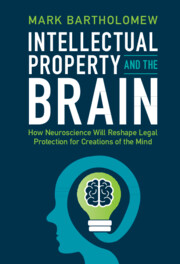 Intellectual Property and the Brain
Intellectual Property and the Brain from Part III - Using Neuroscience to Improve Intellectual Property Law
Published online by Cambridge University Press: 14 July 2022
This chapter details what a better understanding of the creative process should mean for copyright law. Instead of continuing to avoid any rigorous analysis of creativity, courts should investigate authorial motivation and solicit expertise to help diagnose the presence of the required “creative spark.” These changes would bolster copyright’s role in incentivizing the production of creative works while avoiding awards of copyright to unoriginal artworks. The chapter also explains how to recalibrate design patent law in light of what we understand about audience perception of design. The trier of fact should examine whether a design choice makes the design easier or harder for audiences to process. Design choices to be simpler, more prototypical, or more congruous are already likely sufficiently rewarded by consumer choices in the marketplace and should be presumed to lack the originality needed for design patent protection. Through a series of visual examples from actual design patent cases, the chapter explains how, by analyzing the effect of a design choice on visual processing fluency, courts can stop treating all design differences the same.
To save this book to your Kindle, first ensure [email protected] is added to your Approved Personal Document E-mail List under your Personal Document Settings on the Manage Your Content and Devices page of your Amazon account. Then enter the ‘name’ part of your Kindle email address below. Find out more about saving to your Kindle.
Note you can select to save to either the @free.kindle.com or @kindle.com variations. ‘@free.kindle.com’ emails are free but can only be saved to your device when it is connected to wi-fi. ‘@kindle.com’ emails can be delivered even when you are not connected to wi-fi, but note that service fees apply.
Find out more about the Kindle Personal Document Service.
To save content items to your account, please confirm that you agree to abide by our usage policies. If this is the first time you use this feature, you will be asked to authorise Cambridge Core to connect with your account. Find out more about saving content to Dropbox.
To save content items to your account, please confirm that you agree to abide by our usage policies. If this is the first time you use this feature, you will be asked to authorise Cambridge Core to connect with your account. Find out more about saving content to Google Drive.